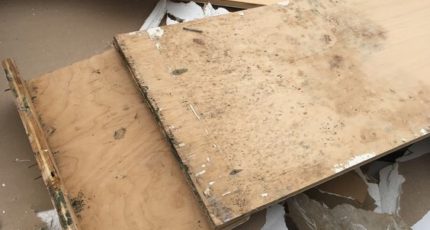
We often stress the importance of assuring a flooded house is properly sanitized and thoroughly dried out before rebuilding.
Unfortunately, we are now seeing fresh examples, a few months after the Hurricane Harvey flooding, of houses with new mold growing because the rebuild was rushed.
Exhibit A: We recently tore out brand-new sheetrock from a rebuilt house. After the flood, another company was hired by the homeowner to tear out damaged materials, including sheet rock. But, they did not tear out the water-logged cabinets, in which mold began to thrive.
Then, the rebuild was done without measuring the moisture that remained in the structure. The homeowner was hoping to move back in, but the tell-tale odor of mold began to take hold. At this point, we were brought in. We found mold behind and under the cabinets. A few cuts in, and we found black mold in the walls behind the sheetrock as well as on the new sheetrock. In short, the quick rebuild was utterly in vain.
We had to tear out the cabinets, the new sheetrock, and the new insulation because they were all moldy. We sanitized with our professional-grade Calbrite antimicrobrial solution. This kills mold and deters new growth on porous (wood) and solid materials.
We also used industrial strength dehumidifiers and air movers. This process differs somewhat from a mold remediation because for that you need a completely contained area. The problem with a flooded house and tear-out is the entire envelope of the house structure is open. Thus, this process is a restoration, not a remediation. The objective is the same: kill mold and prevent new mold.
The new mold was establishing itself throughout the house, but if our intervention had been delayed any further, it would have been worse. Green Star Eco Services Owner, Marc Patel rated this mold situation as a 5 on a 1-10 scale.
“We couldn’t find a lot of mold throughout the structure of the walls. But it’s mainly along the outer walls, which we’re going to go ahead and clean now,” he said at the job site. “They did not take out the cabinets and countertops, which also took out now. So, there was a lot of mold underneath the cabinets and on the inner walls.”
This extra work and new mold could have been prevented, he added.
“This is just case in point of why you need to make sure that the structure is truly, completely ready to go in terms of moisture readings and the appropriate level,” Patel said.
While many homes in southeast Texas may not have been really ready for rebuilding, i.e., appropriately sanitized and dried out, the good news is that trusted general contractors held off on rebuilding.
“We’ve come in behind some tear-outs where the homeowners told us the contractors said they would not rebuild until the house was properly remediated and sprayed and cleaned properly,” Patel said.
“If you have a contractor that’s telling you that, or at least checked by a mold assessor, then your contractor is actually doing you a big favor because it could be very, very expensive and a bad problem if you rebuild over it, and then find out later such as this house here that there is mold in the walls,” he added.
If you experience flooding in your home, from a weather event such as a storm or from a broken pipe, be sure you are working with qualified, licensed professionals who will assess whether the house is primed for a rebuild before you go to that expense and risk incurring mold. We would rather come in and perform our sanitizing and dry out services and be confident you are ready to rebuild.
Otherwise, if a home is rebuilt to soon, we will be facing a much bigger mold cleanup project. Keep Green Star Eco Services in mind if a water disaster strikes or if you find major mold. We pride ourselves on a rapid response and thorough work.
